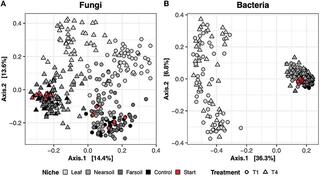The microbiome structure of decomposing plant leaves in soil depends on plant species, soil pore sizes, and soil moisture content
G.M.N. Benucci et al. "The microbiome structure of decomposing plant leaves in soil depends on plant species, soil pore sizes, and soil moisture content" Frontiers in Microbiology 14:1172862 (2023) [DOI:10.3389/fmicb.2023.1172862]
Microbial communities are known as the primary decomposers of all the carbon accumulated in the soil. However, how important soil structure and its conventional or organic management, moisture content, and how different plant species impact this process are less understood. To answer these questions, we generated a soil microcosm with decomposing corn and soy leaves, as well as soil adjacent to the leaves, and compared it to control samples. We then used high-throughput amplicon sequencing of the ITS and 16S rDNA regions to characterize these microbiomes. Leaf microbiomes were the least diverse and the most even in terms of OTU richness and abundance compared to near soil and far soil, especially in their bacterial component. Microbial composition was significantly and primarily affected by niche (leaves vs. soil) but also by soil management type and plant species in the fungal microbiome, while moisture content and pore sizes were more important drivers for the bacterial communities. The pore size effect was significantly dependent on moisture content, but only in the organic management type. Overall, our results refine our understanding of the decomposition of carbon residues in the soil and the factors that influence it, which are key for environmental sustainability and for evaluating changes in ecosystem functions.
Raw ITS and 16S sequences .fastq reads were submitted to the Sequence Read Archive (Leinonen et al., 2011) under the bioproject number PRJNA938072. Data sets, and R code developed to analyze them, are accessible at: https://github.com/Gian77/Scientific-Papers-R-Code. Additional material associated with this article is also available in the Supplementary material.
